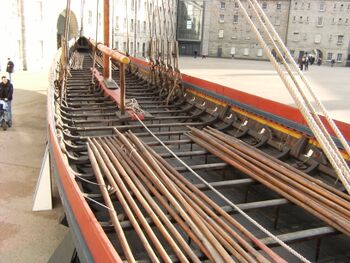Sea Stallion: Difference between revisions
imported>Robert W King No edit summary |
mNo edit summary |
||
| (24 intermediate revisions by 8 users not shown) | |||
| Line 1: | Line 1: | ||
[Image | {{subpages}} | ||
{{dambigbox|text=For the Sea Stallion helicopter, see [[CH-53 Sea Stallion]].}} | |||
The '''''Sea Stallion''''', fully titled the ''Sea Stallion of Glendalough'', is a modern-day authentic reconstruction of a 30-metre [[Viking | {{Image|Dublin WK 002 02.jpg|right|300px|The Sea Stallion arrives in [[Dublin]].}} | ||
The '''''Sea Stallion''''', fully titled the ''Sea Stallion of Glendalough'', is a modern-day authentic reconstruction of a 30-metre [[Viking longship]]. She is modelled on a wreck, the ''Skuldelev 2'', recovered from [[Roskilde]] Fjord in [[Denmark]]. | |||
==Skuldelev 2== | ==Skuldelev 2== | ||
The original ship was constructed by | The original ship was constructed by Viking settlers in Ireland, around the year 1042, using oak wood from [[Glendalough]] in [[County Wicklow]]. The ship, along with 4 others, was scuttled some 30 years later in Roskilde Fjord in order to prevent access to the [[fjord]] by enemies. The wrecks were discovered in 1962. The Skuldelev 2 is now housed in the Viking Ship Musueum. | ||
A [[marine archaeology]] project to build Skuldelev 2's replica, the ''Sea Stallion of Glendalough'', was initiated by the museum. Using authentic materials and building methods, with replica tools, the ship was built between 2000 and 2004. The reconstruction project and its associated voyage | A [[marine archaeology]] project to build Skuldelev 2's replica, the ''Sea Stallion of Glendalough'', was initiated by the museum. Using authentic materials and building methods, with replica tools, the ship was built between 2000 and 2004. The reconstruction project and its associated voyage aimed to shed light on the logistics of Viking shipbuilding, sailing and society. | ||
==Voyage== | ==Voyage== | ||
A crew of 65 Danish and Irish volunteers sailed the ship from Denmark to [[Ireland (state)|Ireland]]. It departed from Roskilde on 1st July, 2007, and arrived in Ireland safely, sailing up the [[River Liffey]] in [[Dublin]] on 14th August, 2007. Their course took them across the [[North Sea]], where they faced [[Beaufort Scale|force 9]] gales and had to be towed for a time, down past [[Scotland]], and through the [[Irish Sea]] to Dublin. | A crew of 65 Danish and Irish volunteers sailed the ship from Denmark to [[Ireland (state)|Ireland]]. It departed from Roskilde on 1st July, 2007, and arrived in Ireland safely, sailing up the [[River Liffey]] in [[Dublin]] on 14th August, 2007. Their course took them across the [[North Sea]], where they faced [[Beaufort Scale|force 9]] gales and had to be towed for a time, down past [[Scotland]], and through the [[Irish Sea]] to Dublin. | ||
The ''Sea Stallion'' | The ''Sea Stallion'' was housed on land, at [[Collins Barracks]], until summer 2008, when it was refloated and made the return voyage to Denmark. | ||
{{Image|Seastallion1.jpg|right|350px|Closeup of the open deck.}} | |||
==Sources== | ==Sources== | ||
* [http://www.havhingsten.dk/index.php?id=277&L=1 Sea Stallion of Glendalough] | * [http://www.havhingsten.dk/index.php?id=277&L=1 Sea Stallion of Glendalough] | ||
==References== | ==References== | ||
<div class="references-small"><references/></div> | <div class="references-small"><references/></div>[[Category:Suggestion Bot Tag]] | ||
[[Category: | |||
Latest revision as of 11:00, 16 October 2024
The Sea Stallion, fully titled the Sea Stallion of Glendalough, is a modern-day authentic reconstruction of a 30-metre Viking longship. She is modelled on a wreck, the Skuldelev 2, recovered from Roskilde Fjord in Denmark.
Skuldelev 2
The original ship was constructed by Viking settlers in Ireland, around the year 1042, using oak wood from Glendalough in County Wicklow. The ship, along with 4 others, was scuttled some 30 years later in Roskilde Fjord in order to prevent access to the fjord by enemies. The wrecks were discovered in 1962. The Skuldelev 2 is now housed in the Viking Ship Musueum.
A marine archaeology project to build Skuldelev 2's replica, the Sea Stallion of Glendalough, was initiated by the museum. Using authentic materials and building methods, with replica tools, the ship was built between 2000 and 2004. The reconstruction project and its associated voyage aimed to shed light on the logistics of Viking shipbuilding, sailing and society.
Voyage
A crew of 65 Danish and Irish volunteers sailed the ship from Denmark to Ireland. It departed from Roskilde on 1st July, 2007, and arrived in Ireland safely, sailing up the River Liffey in Dublin on 14th August, 2007. Their course took them across the North Sea, where they faced force 9 gales and had to be towed for a time, down past Scotland, and through the Irish Sea to Dublin.
The Sea Stallion was housed on land, at Collins Barracks, until summer 2008, when it was refloated and made the return voyage to Denmark.

